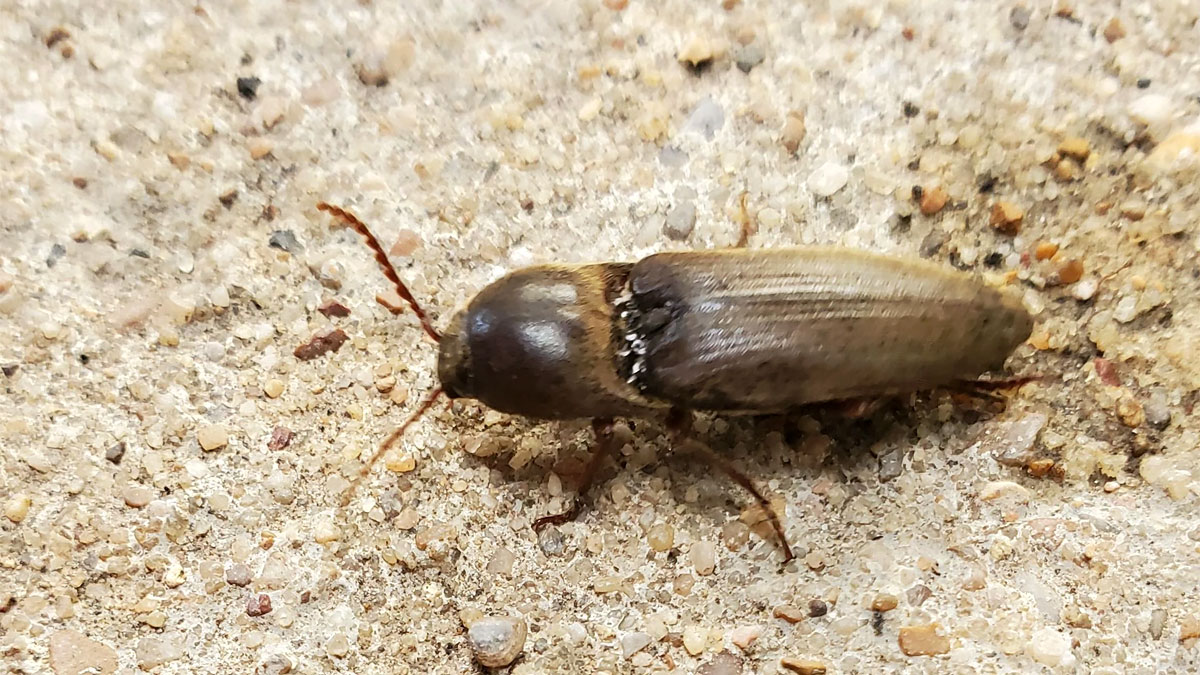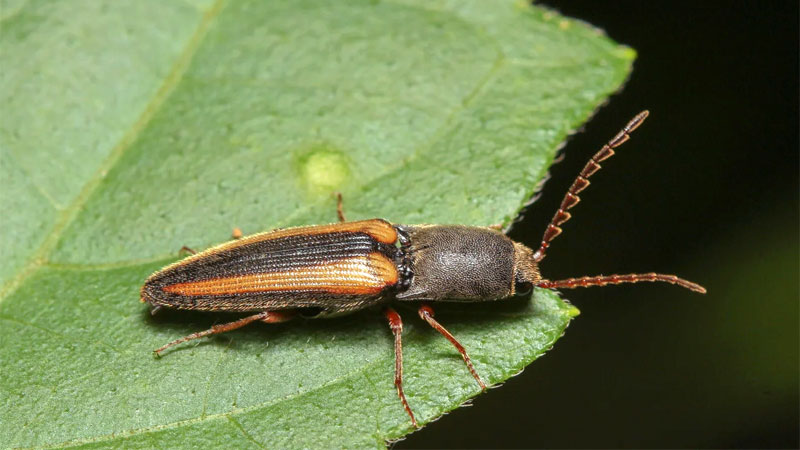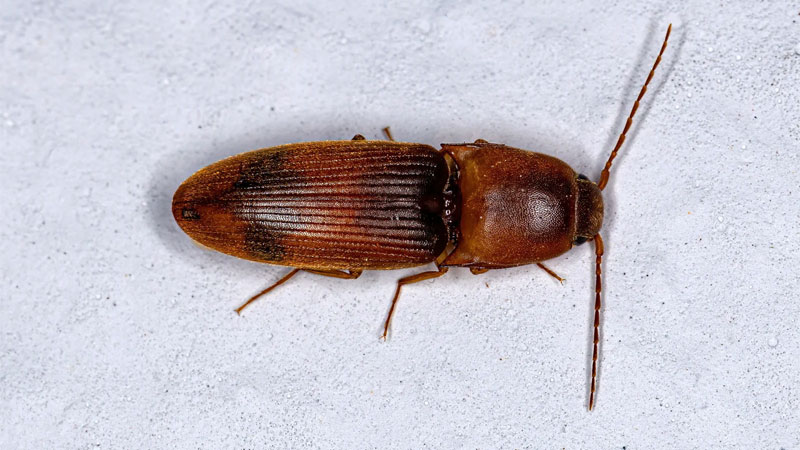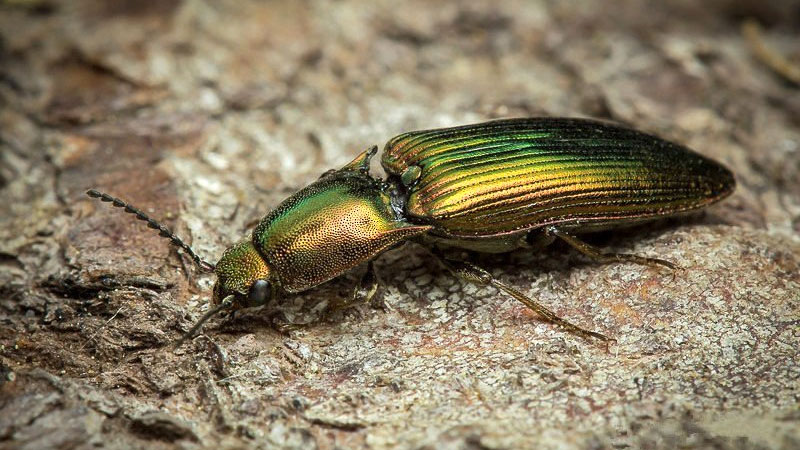Named for the clicking noise they make when flipping themselves over, the click beetle is a common pest throughout the US. Just how worried should you be when you spot one, and how do you eliminate an infestation?
Let’s look at some popular remedies, as well as prevention methods for click beetles and their larvae, wireworms. Then, we’ll take a closer look at these critters and see what makes them tick (or should that be click?).
Getting Rid of Click Beetles
Dealing with a click beetle infestation outdoors can be quite difficult, but not impossible. Thankfully, they’re not known to be a problem as household pests and can be removed easily.
Here’s everything you need to know about eliminating both the beetle larvae and adults.
In the Garden
The garden is where these critters do the most damage, although not all species are a threat. Of the nearly 1,000 species found in North America, the ones to watch out for are usually have black or brown bodies. Thankfully, it can be easy to reduce or eliminate a population once you’ve discovered it.
See Also: Asian Lady Beetle Infestation? (Here’s What To Do)
Neem Oil
Neem oil is one of our favorite remedies for a variety of insects for some very good reasons: it’s non-toxic to humans, generally safe around non-aquatic pets, and is extremely effective.
Use neem foliar sprays to protect or shine the leaves of your plants. Alternatively, you can create a neem soil soak that functions as a systemic insecticide, protecting plants for up to 22 days from biting or chewing pests.
The soil soak is especially effective against click beetles, as the egg and larval stages remain underground. Reapply every two to three weeks until the problem is gone, then use it every three weeks as a preventative. It won’t harm worms but will kill most grubs and beetle larvae.
Always test a plant for sensitivity before using neem. Apply it at dusk or dawn so there’s minimal risk of harming beneficial insects (the foliar spray evaporates in an hour or less with no residue). Just be careful not to use it near inhabited bodies of water.
Pesticides
There’s a wide range of pesticidal products out there that will work on beetles and their larvae. Some lawn fertilizers include pesticides as a feature, or you can go with granules, sprays, or powders.
Just be warned that these are toxic around pets and children. There’s also a risk of creating superbugs if you use the same product too many times in a row.
If you do choose to go with a pesticide, be sure the label specifies that it will work on beetles and follow all instructions carefully. It’s also best to alternate brands each time you apply, as doing so helps prevent bugs from developing a resistance.
Note that pyrethrin-based insecticides (like this) tend to be among the most effective against beetles.
Natural Predators
Both adult beetles and their larvae can be tasty treats for a number of birds, lizards, and spiders. Try creating a hospitable environment for these critters in a corner of your property. Just be warned, they can also end up becoming pests in their own right.
Also, while they can help manage the infestation, they won’t be able to eliminate your problem on their own.
Call a Professional
Let’s face it, sometimes DIY methods work like a charm, and sometimes they prove totally useless. Mileage can vary greatly, so don’t feel ashamed to phone a professional pest control service if your efforts aren’t working.
They are often more affordable than you expect, and any reputable company will provide a warranty and free or low-cost follow-up services.
In the Home
Getting rid of click beetles in the house is a lot simpler than fighting them outdoors. This is due to the fact that adult click beetles aren’t fans of mating indoors. Instead, you can usually get away with spot treatments. A few common tactics include:
Pesticidal Sprays
Grab a can of Raid or a similar bug spray (make sure beetles are listed on the label!) and spray them when you see one. Chances are, you’ll eliminate all of the intruders after only a few shots.
Vacuum Them Up
As usual, a vacuum cleaner can be one of your most reliable allies. Simply suck up the beetles as you encounter them and make sure to dispose of the bag or canister contents in a safe place so there are no escapees.
Read Also: Getting Rid of Carpet Beetles
Preventing Click Beetles
Prevention is almost always the best medicine, and usually much cheaper in the long run. Of course, it’s easier to keep click beetles out of your home than it is keeping them from your yard and garden.
The following methods will greatly reduce the risk of an infestation while also helping to keep many other pests away.
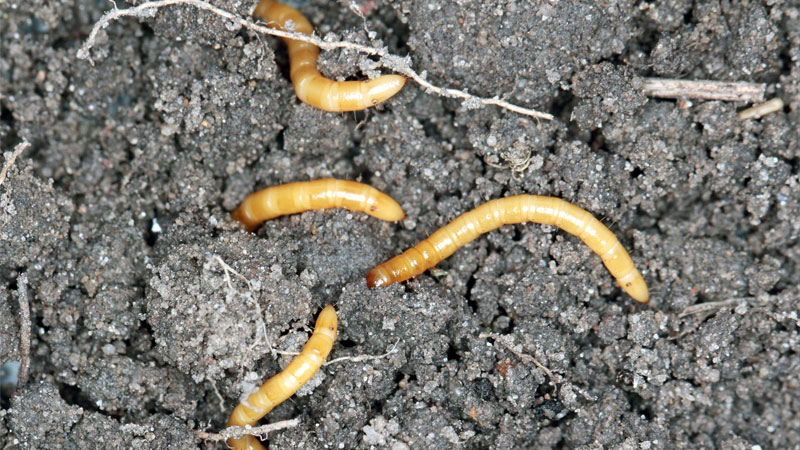
Home Exclusion Tactics
Click beetles are only occasional invaders and don’t pose the same problems as more common household pests. However, this doesn’t mean you want them getting inside. By using exclusion tactics, you can keep these bugs (and a whole host of other pests) outside where they belong.
Create a Barrier Defense
One of the best tactics you can use against a number of insect pests is to create a no man’s land around your foundation. Prune back any shrubs and remove any plants so there’s a 6-inch barren strip around your entire home. Cover this with coarse sand or pea gravel so plants won’t grow and bugs can’t simply tunnel under it.
To add extra security, you can use a barrier pesticide like Ortho Home Defense. These residual products can last several months and will kill any bugs that try to cross that barrier.
Meanwhile, birds and other predators will have a clear view if any insect is brave enough to try and cross the barrier.
Seal Entry Points
Most homes (especially older ones) have a lot of small holes in them that can increase your heating bills and let all sorts of critters in. You should examine the exterior of your home annually and seal these entry points as you discover them.
This also includes ensuring all windows have intact screens and the caulking around your doors and windows hasn’t been compromised.
Outdoor Exclusion Tactics
Remove Any Debris
A clean lawn and garden means fewer placed for the adult beetles to hide. It will also deter a number of other critters as a bonus.
Turn Off Outdoor Lights
If you aren’t outside, be sure to turn off any unnecessary outdoor lighting. Not only are many bugs attracted to the lights, but so are plenty of other pests looking for a snack.
Use Complimentary Gardening
Complimentary gardening (AKA companion planting) is a technique where you use plants to protect other plants. Try placing lavender or peppermint near crops that click beetles like to target. The smell is pleasant to us, but is avoided by many pests.
Getting to Know Click Beetles
Click beetles come from the family Elateridae. There are around 9,300 known species with 965 calling North America home. They’re sometimes referred to as elaters, snapping beetles, spring beetles or skipjacks.
Identifying Click Beetles
Most species are brown, reddish brown, or black, with some tropical species having brighter coloration. Their size tends to range from 1/2 to one inch and they rarely have markings. However, the beneficial eyed elator (Alaus oculatus) is a whopping 1.5 inches and has eye-like markings on its thorax.
Wireworms, their larvae, have six legs and a long abdomen. They tend to resemble mealworms, but have a protective exoskeleton. As with adults, size and shape varies.
Claim to Fame
These critters get their common name from a special adaptation on their thorax. A little spine located on their underside in the section of thorax containing their front pair of legs can slot into a notch in the segment with the second pair of legs.
This allows the beetle to leap into the air with a loud click. While primarily used to scare predators, it can also be used to flip a beetle that landed on its back. It’s also great at driving adult humans crazy (but kids love it).
Click Beetle Life Cycle
Female click beetles lay their eggs during spring or summer, either on dead plant matter or the ground. They usually take 3-10 days to hatch into wireworms. This larval phase can be as short as a year, but most species remain for two to six years. They become pupae in summer, then emerge as adults the following spring.
Why Are Click Beetles in My House?
Adults are known to wander in on hot days, and it’s possible to unknowingly bring a wireworm in when they’ve infested a potted plant’s soil. Thankfully, adults won’t breed indoors and they’ll often wander back out on their own.
Are Click Beetles Dangerous?
Click beetles are harmless to humans beyond being nuisance pests. Adults feed on nectar and can pollinate. Wireworms will feed on dead matter, other larvae, or can damage crops, depending on the species. Target crops include cotton, grains, maize, potatoes, as well as plant roots in general.
- How to Get Rid of Click Beetles (and Wireworms) - May 5, 2024
- How to Get Rid of Hawks - March 8, 2024
- How to Get Rid of Pill Bugs (Rolly Pollies) - March 1, 2024

